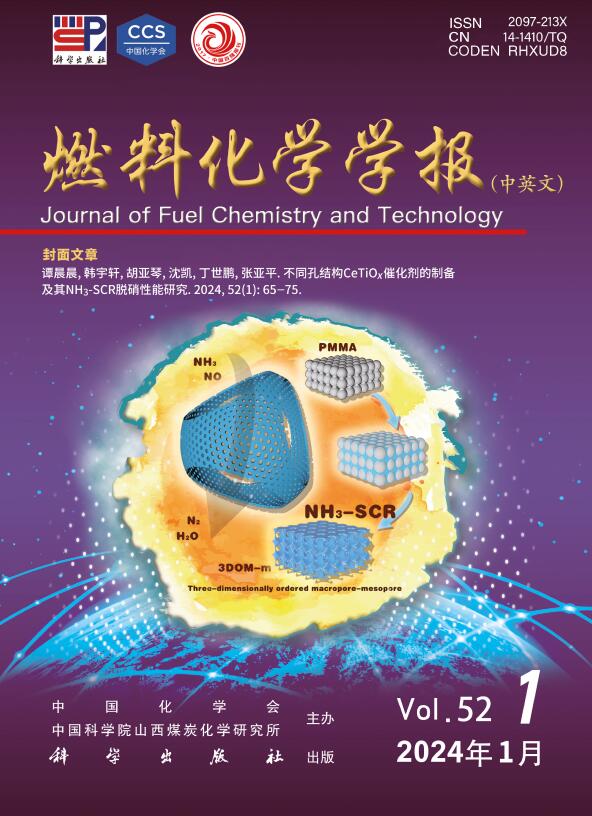Structure-activity relationships and catalytic performances of Ag- and Zn-doped Cu/MOR for methane C−H bond activation
Q3 Energy
引用次数: 0
Abstract
Efficient activation of the C-H bond in methane (CH4) is critical for achieving methane conversion at low-temperature. In this study, based on theoretical screening using the spin density (ρ) of active O atom as the activity descriptor, density functional theory (DFT) was utilized to investigate the adsorption of CH4 and the mechanism of the subsequent C−H bond activation on Ag- and Zn-doped [Cu3O3]2+/mordenite (MOR) surfaces, as well as Zn-doped [CuOCu]2+/MOR surfaces, with high ρ values indicating high catalytic activation. The results demonstrated that CH4 was physisorbed onto active O atom, followed by further activated to yield CH3' radicals and surface OH groups via the radical reaction mechanism. Both Ag and Zn doping reduced the activation energy and reaction energy for the cleavage of the C−H bond in CH4, promoting the C−H activation. Further electronic structure analysis revealed the spin polarization of electronic orbitals for both the active O atom and its bonded metal atoms. After Ag doping in [Cu3O3]2+/MOR, the formation of an Ag–O bond increased the gap between the spin-up and spin-down p-band centers of O 2p (Δεp) and its spin density, which consequently enhanced the catalytic performance of the active O atom for C−H bond activation in CH4. Zn doping into both [Cu3O3]2+/MOR and [CuOCu]2+/MOR also increased Δεp. Specifically, when the Zn 4s and Zn 4p orbitals shifted downward to appropriate low energy levels, Zn 4s and Zn 4p interacted with O 2p to induce half-metallic characteristic in active O atom. This half-metallic characteristic exceptionally promoted C−H bond activation in CH4, which was insufficiently predicted by the activity descriptors Δεp and ρ.
Ag和zn掺杂Cu/MOR对甲烷C−H键活化的构效关系及催化性能
甲烷(CH4)中C-H键的有效活化是实现甲烷低温转化的关键。在本研究中,以活性O原子的自旋密度(ρ)作为活性描述符进行理论筛选,利用密度泛函理论(DFT)研究了CH4在Ag-和zn掺杂[Cu3O3]2+/ MOR表面以及zn掺杂[CuOCu]2+/MOR表面的吸附和随后的C−H键活化机理,ρ值越高表明催化活性越高。结果表明,CH4被物理吸附到活性O原子上,然后通过自由基反应机理被进一步活化生成CH3'自由基和表面OH基团。Ag和Zn的掺杂均降低了CH4中C−H键裂解的活化能和反应能,促进了C−H的活化。进一步的电子结构分析揭示了活性O原子及其键合金属原子的电子轨道的自旋极化。Ag在[Cu3O3]2+/MOR中掺杂后,Ag - O键的形成增加了o2p (Δεp)的自旋上下p带中心之间的间隙和自旋密度,从而增强了活性O原子对CH4中C−H键活化的催化性能。Zn掺杂到[Cu3O3]2+/MOR和[CuOCu]2+/MOR中也增加了Δεp。具体来说,当Zn 4s和Zn 4p轨道向下移动到适当的低能级时,Zn 4s和Zn 4p与o2p相互作用,在活性O原子中诱发半金属特征。这种半金属特征特别促进了CH4中C−H键的活化,这是活性描述符Δεp和ρ不能充分预测的。
本文章由计算机程序翻译,如有差异,请以英文原文为准。
求助全文
约1分钟内获得全文
求助全文
来源期刊

燃料化学学报
Chemical Engineering-Chemical Engineering (all)
CiteScore
2.80
自引率
0.00%
发文量
5825
期刊介绍:
Journal of Fuel Chemistry and Technology (Ranliao Huaxue Xuebao) is a Chinese Academy of Sciences(CAS) journal started in 1956, sponsored by the Chinese Chemical Society and the Institute of Coal Chemistry, Chinese Academy of Sciences(CAS). The journal is published bimonthly by Science Press in China and widely distributed in about 20 countries. Journal of Fuel Chemistry and Technology publishes reports of both basic and applied research in the chemistry and chemical engineering of many energy sources, including that involved in the nature, processing and utilization of coal, petroleum, oil shale, natural gas, biomass and synfuels, as well as related subjects of increasing interest such as C1 chemistry, pollutions control and new catalytic materials. Types of publications include original research articles, short communications, research notes and reviews. Both domestic and international contributors are welcome. Manuscripts written in Chinese or English will be accepted. Additional English titles, abstracts and key words should be included in Chinese manuscripts. All manuscripts are subject to critical review by the editorial committee, which is composed of about 10 foreign and 50 Chinese experts in fuel science. Journal of Fuel Chemistry and Technology has been a source of primary research work in fuel chemistry as a Chinese core scientific periodical.
 求助内容:
求助内容: 应助结果提醒方式:
应助结果提醒方式:


